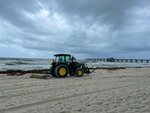It smells terrible. It looks totally gross. And it drives visitors and profits away from pristine beaches, fast. And ew. Did it touch your feet? Soon, it might be everywhere. A giant blob of algae, …
This item is available in full to subscribers.
Please log in to continue |


It smells terrible. It looks totally gross. And it drives visitors and profits away from pristine beaches, fast.
And ew. Did it touch your feet?
Soon, it might be everywhere.
A giant blob of algae, known as sargassum, has begun hitting Florida's beaches. This is normal. The giant mass of algae has floated back and forth across the Atlantic so long it was noted by European explorers who first sailed to the Americas.
What is not normal is its size.
Since 2011, a 5,000-mile-long belt of the seaweed has circulated each year between the Gulf of Mexico and the mid-Atlantic, and it keeps getting bigger.
In April, the University of South Florida Optical Oceanography lab reported that the overall belt of algae had reached an estimated 13 million tons in the Caribbean Sea, a new record.
For beach-lovers and municipalities waiting to see where it will land, that's a potential problem.
What is it?
Sargassum is a type of floating brown algae that people commonly refer to as seaweed. It has no roots and doesn't attach to the ocean floor. Think of the plants pet stores sell to float on the top of aquariums; that is similar.
You can jump into sargassum, swim around and under it. There are no entanglement issues for swimmers who encounter sargassum.
In fact, Sean P. Powers, Ph.D., director of the USA School of Marine and Environmental Sciences, encourages swimmers to play in the sargassum.
"In the ocean; it's alive. I tell people to snorkel around the edges because there is amazing life in there," he said. "It is the only natural habitat in the ocean that is on the surface, and it's very neat stuff."
Why is it growing larger?
Powers said the sargassum belt's expansion is fueled by climate change and human activity.
The algae have been blooming bigger and brighter in recent years off the coast of Africa. Powers said some theorize that those blooms are fueled by dust storms rolling off the continent that are rich in micronutrients like iron.
Those dust storms are the result of deforestation by humans, he said.
"Those nutrients are not being absorbed into the forest now and instead being washed into the ocean," Powers said. "Now, there is a new source for growth and is the most likely explanation for why its blooming so heavily."
The nutrients feed the algae, it grows, and the winds carry it across the sea. It moves more like a conveyor belt and less like a floating blob, Powers said, stretching for miles.
As it floats, it provides a nursery of sorts for fish, providing shelter and nutrients for all types of sea life.
Where is it going?
It's hard to know for sure.
It all depends on winds, and winds, Powers said, "are weird."
Winds with a westerly component will keep the mass out of the Gulf of Mexico and away from Alabama beaches. But the models that predict that movement are not reliable for long-term predictions.
Will it wash up in Alabama?
Probably.
Alabama beaches regularly have sargassum land on their shores, but that algae usually flows from a bloom in Texas.
The bloom heading toward the Caribbean from Africa is a new source of sargassum for the Gulf, Powers said, so scientists are less sure of where it will travel.
"It's just so much though. Some of it is surely going to make it to Alabama beaches," he said. "How much depends on the strength and the direction of the winds this summer."
In 2022, Gulf State Park moved rolls of sargassum that landed on the beaches there back into the dunes to help strengthen those structures.
When sargassum washes up on shore, like any marine life, it dies when it leaves the water.
That's when it begins to decompose and stink. As it rots, it releases hydrogen sulfide and smells like rotting eggs.
There's some evidence to show that those gases can cause nausea and headaches or aggravate respiratory issues.
Reuters reported that in 2018 doctors on the islands of Guadeloupe and Martinique reported more than 11,000 cases of "acute sargassum toxicity" during an eight-month period of intense sargassum buildup on the beaches there.
Powers said individuals with asthma or other breathing problems may experience discomfort if they are near a rotting mass of sargassum.
What do we do with it?
Rotting sargassum needs to be disposed of and can't be used for fertilizer or in farming.
The algae are rich in heavy metals, particularly arsenic. Unfortunately, farmers in the Caribbean who experimented with using the mass as fertilizer found that the arsenic is passed on to crops grown in it.
"Obviously, that isn't a real good thing," Powers said.
That leaves just one option for cities and states dealing with the cleanup — bury it and let it rot away.
"It's going to be a nuisance and an inconvenience and cause hotels and coastal communities money to remove this stuff and scrape the beaches, but this doesn't really pose any major threat," Powers said. "When the national media picked up the story, I think it really caused people to worry a lot because it is something that is definitely increasing because of human activity. "But mostly, it's just going to be a large nuisance."